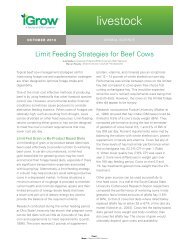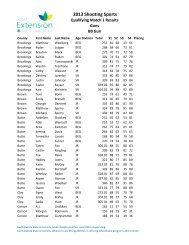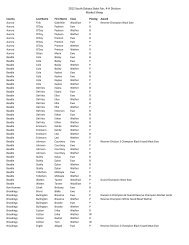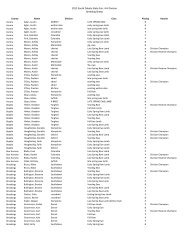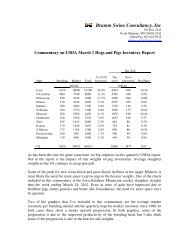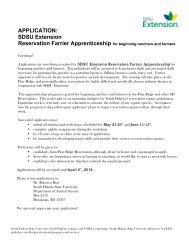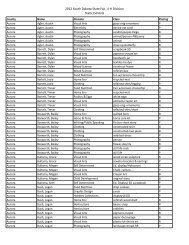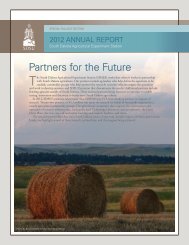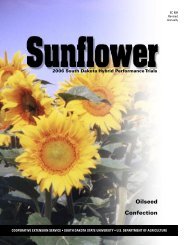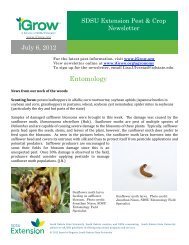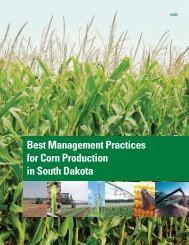Best Management Practices for Corn Production in South Dakota
Best Management Practices for Corn Production in South Dakota
Best Management Practices for Corn Production in South Dakota
You also want an ePaper? Increase the reach of your titles
YUMPU automatically turns print PDFs into web optimized ePapers that Google loves.
Western bean cutworm management<br />
Bt-corn hybrids with Herculex® I and Herculex® X-TRA genes produce the Cry1F prote<strong>in</strong> that<br />
provides resistance to western bean cutworm larvae. However, Bt-corn hybrids with YieldGard® <strong>Corn</strong><br />
Borer, YieldGard® Plus, YieldGard® VT Triple, Agrisure® CB, and Agrisure® CB/RW genes do not provide<br />
resistance to western bean cutworm larvae.<br />
Western cutworm scout<strong>in</strong>g and <strong>in</strong>secticides<br />
Scout<strong>in</strong>g <strong>for</strong> western bean cutworms should start at the V16 (green tassel) stage and cont<strong>in</strong>ue<br />
through the R3 (milk) stage. Eggs and newly hatched larvae are usually found <strong>in</strong> the silks or leaves <strong>in</strong><br />
the upper canopy. Because the tim<strong>in</strong>g of spray application is very important (the <strong>in</strong>secticide must be<br />
applied be<strong>for</strong>e the larvae enter the ears), scout<strong>in</strong>g must also be timed accord<strong>in</strong>gly. At least 100 plants<br />
(10 plants from 10 locations on the field) per 40-acre field must be <strong>in</strong>spected to accurately gauge the<br />
<strong>in</strong>festation level. Both the center and borders of the cornfield must be <strong>in</strong>spected. This pest should be<br />
controlled if 8% of the plants have eggs or newly hatched larvae. For <strong>in</strong>secticides to be effective, the<br />
<strong>in</strong>secticide must be applied be<strong>for</strong>e the larvae enter the ears. In<strong>for</strong>mation on different <strong>in</strong>secticides is<br />
available at the SDSU Extension Entomology Web site (http://plantsci.sdstate.edu/ent/).<br />
Black Cutworm (Agrotis ipsilon)<br />
Pest highlights<br />
<br />
<strong>in</strong> the season.<br />
Bt-corn<br />
hybrids are effective aga<strong>in</strong>st this pest.<br />
<br />
significant stand loss can result.<br />
kota.<br />
Moths migrate <strong>in</strong>to the state <strong>in</strong> early spr<strong>in</strong>g<br />
and are attracted to wet and weedy fields.<br />
Black cutworm description<br />
A full-grown larva is about 1½-<strong>in</strong>ches long, dark<br />
brown to black, and “greasy” <strong>in</strong> appearance (fig. 8.13).<br />
Under the microscope or hand lens, the sk<strong>in</strong> of the<br />
larva has a rough, pebbly texture. The pupa is brown<br />
and about ¾-<strong>in</strong>ch long (fig. 8.13).<br />
Black cutworm biology<br />
Moths start migrat<strong>in</strong>g <strong>in</strong>to <strong>South</strong> <strong>Dakota</strong> from<br />
southern states <strong>in</strong> early April. <strong>South</strong>erly w<strong>in</strong>ds <strong>in</strong>fluence<br />
the transport, distribution, and severity of black<br />
cutworm <strong>in</strong>festations. Eggs are deposited on weeds<br />
and crop residues be<strong>for</strong>e corn is planted. Black cutworm<br />
larvae <strong>in</strong>itially feed on weeds, then move to corn<br />
Figure 8.13. Black cutworm larvae, pupa, and cut<br />
seedl<strong>in</strong>g<br />
(Photo courtesy of Mike Catangui, <strong>South</strong> <strong>Dakota</strong> State University)<br />
Figure 8.14. Miss<strong>in</strong>g corn seedl<strong>in</strong>gs due to black<br />
cutworm <strong>in</strong>jury<br />
(Photo courtesy of Mike Catangui, <strong>South</strong> <strong>Dakota</strong> State University)<br />
seedl<strong>in</strong>gs <strong>in</strong> May through early June. <strong>Corn</strong> seedl<strong>in</strong>gs can be cut underground, below the grow<strong>in</strong>g po<strong>in</strong>t,<br />
result<strong>in</strong>g <strong>in</strong> extensive seedl<strong>in</strong>g stand loss (fig. 8.14).<br />
Black cutworm management<br />
Only Bt-corn hybrids with Herculex® I and Herculex® X-TRA are considered resistant to black<br />
cutworm larvae. Seed treatments of clothianid<strong>in</strong> or thiamethoxam provide protection from cutworm<br />
damage.<br />
Black cutworm scout<strong>in</strong>g and <strong>in</strong>secticides<br />
Scout<strong>in</strong>g <strong>for</strong> black cutworm larvae should start at the VE (germ<strong>in</strong>ation and emergence) stage and cont<strong>in</strong>ue<br />
on through V4 (fourth leaf). Insecticide treatment is recommended if 5% (1 <strong>in</strong> 20) of the seedl<strong>in</strong>gs<br />
show signs of cutt<strong>in</strong>g or leaf feed<strong>in</strong>g and if the larvae are less than 1-<strong>in</strong>ch long. In<strong>for</strong>mation on different<br />
<strong>in</strong>secticides is available at the SDSU Extension Entomology Web site (http://plantsci.sdstate.edu/ent/).<br />
CHAPTER 8: <strong>Corn</strong> Insect Pests 55



